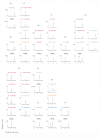Juvenile hormone III skipped bisepoxide is widespread in true bugs (Hemiptera: Heteroptera)
- PMID: 33972884
- PMCID: PMC8074663
- DOI: 10.1098/rsos.202242
Juvenile hormone III skipped bisepoxide is widespread in true bugs (Hemiptera: Heteroptera)
Abstract
Juvenile hormone (JH) plays important roles in almost every aspect of insect development and reproduction. JHs are a group of acyclic sesquiterpenoids, and their farnesol backbone has been chemically modified to generate a homologous series of hormones in some insect lineages. JH III (methyl farnesoate, 10,11-epoxide) is the most common JH in insects, but Lepidoptera (butterflies and moths) and 'higher' Diptera (suborder: Brachycera; flies) have developed their own unique JHs. Although JH was first proposed in the hemipteran suborder Heteroptera (true bugs), the chemical identity of the heteropteran JH was only recently determined. Furthermore, recent studies revealed the presence of a novel JH, JH III skipped bisepoxide (JHSB3), in some heteropterans, but its taxonomic distribution remains largely unknown. In the present study, we investigated JHSB3 production in 31 heteropteran species, covering almost all heteropteran lineages, through ultra-performance liquid chromatography coupled with tandem mass spectrometry. We found that all of the focal species produced JHSB3, indicating that JHSB3 is widespread in heteropteran bugs and the evolutionary occurrence of JHSB3 ascends to the common ancestor of Heteroptera.
Keywords: Hemiptera; Heteroptera; juvenile hormone; juvenile hormone III skipped bisepoxide; true bugs; ultra-performance liquid chromatography coupled with tandem mass spectrometry.
© 2021 The Authors.
Figures



Similar articles
-
Juvenile hormone III skipped bisepoxide, not its stereoisomers, as a juvenile hormone of the bean bug Riptortus pedestris.Gen Comp Endocrinol. 2020 Apr 1;289:113394. doi: 10.1016/j.ygcen.2020.113394. Epub 2020 Jan 18. Gen Comp Endocrinol. 2020. PMID: 31962126
-
Juvenile hormone identification in the cabbage bug Eurydema rugosa.Bull Entomol Res. 2023 Jun;113(3):293-298. doi: 10.1017/S0007485321000158. Epub 2023 Mar 8. Bull Entomol Res. 2023. PMID: 36883785
-
Common structural features facilitate the simultaneous identification and quantification of the five most common juvenile hormones by liquid chromatography-tandem mass spectrometry.Insect Biochem Mol Biol. 2020 Jan;116:103287. doi: 10.1016/j.ibmb.2019.103287. Epub 2019 Nov 21. Insect Biochem Mol Biol. 2020. PMID: 31760138 Free PMC article.
-
Approaches and Tools to Study the Roles of Juvenile Hormones in Controlling Insect Biology.Insects. 2020 Dec 3;11(12):858. doi: 10.3390/insects11120858. Insects. 2020. PMID: 33287115 Free PMC article. Review.
-
Regulation of female reproduction in mites: a unifying model for the Acari.J Insect Physiol. 2009 Dec;55(12):1079-90. doi: 10.1016/j.jinsphys.2009.08.007. Epub 2009 Aug 28. J Insect Physiol. 2009. PMID: 19698719 Review.
Cited by
-
Design, synthesis, and biological evaluation of insect hormone agonists.J Pestic Sci. 2024 Nov 20;49(4):303-310. doi: 10.1584/jpestics.J24-02. J Pestic Sci. 2024. PMID: 39877879 Free PMC article.
-
Evolution of proteins involved in the final steps of juvenile hormone synthesis.J Insect Physiol. 2023 Mar;145:104487. doi: 10.1016/j.jinsphys.2023.104487. Epub 2023 Jan 25. J Insect Physiol. 2023. PMID: 36707023 Free PMC article.
-
Crosstalk between Nutrition, Insulin, Juvenile Hormone, and Ecdysteroid Signaling in the Classical Insect Model, Rhodnius prolixus.Int J Mol Sci. 2022 Dec 20;24(1):7. doi: 10.3390/ijms24010007. Int J Mol Sci. 2022. PMID: 36613451 Free PMC article.
References
-
- Henry TJ. 2017. Biodiversity of Heteroptera. In Insect biodiversity: science and society, vol. 1 (eds Foottit RG, Adler PH), pp. 279-335. Hoboken, NJ: John Wiley & Sons.
-
- Schaefer C.W, Panizzi AR. 2000. Heteroptera of economic importance, p. 850. Boca Raton, FL: CRC Press.
-
- Wigglesworth VB. 1934. The physiology of ecdysis in Rhodnius prolixus (Hemiptera). II. Factors controlling moulting and ‘metamorphosis’. Q. J. Microscop. Sci. 77, 191-222.
Associated data
LinkOut - more resources
Full Text Sources
Other Literature Sources

